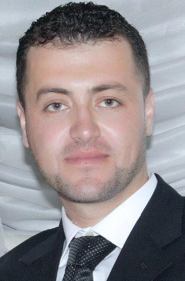Bio-inspired Hair Flow Sensor Arrays: From Nature to MEMS
Promotion date: 21st December 2011
Promotor: Prof. dr. ir. Gijs Krijnen
Assistant promotor: Dr. ir. Remco Wiegerink
| Hair-based flow sensors (i.e. cercus) in crickets are an example of a biological system that has recently attracted great interest from engineers. With this system, crickets are able to detect approaching spiders utilizing the airflow. A bio-inspired hair flow-sensor has been realized in our group (Transducers Science and Technology) exploiting surface micromachning in Micro-Electro-Mechanical Systems (MEMS) fabrication techniques. The work reported in this thesis addresses the track to develop highly-sensitive sensory systems (made of arrays of artificial hair sensors) towards fulfilling the basic requirements of an airflow camera. The ability of the hair sensor to perform useful flow field measurements was examined by means of dipole flow field observations. Aiming at performing spatio-temporal pattern recognition of flow events, arrays of these hairs can be advantageous in extracting meaningful information from distributed measurements rather than just performing (averaged) local measurements at sensor position. We believe that our target, the development of airflow camera’s to be applied in spatio-temporal fluid monitoring, is achievable using MEMS hair-sensors hand-in-hand with insights from nature.
|
In your thesis you are inspired by nature.
Learning from nature can be very useful and rewarding as the functionalities are optimized during millions of years of evolution. Understanding the fundamental mechanisms in detail, we can mimic a natural system to an artificial one with performance as close as possible to the natural one, like in our case airflow hair sensors inspired by hair sensors in crickets to detect minute air movements.
However, it is not possible to exactly copy natural systems as the structure and the materials of naturally existing systems can’t be exactly reproduced like hair sensors in crickets which are somehow different from the artificial hairs we make. In addition, the way the signals are processed is an important feature of the success of crickets to react on minute airflows. We identify the basic design properties and adapt them for our goals and needs.
In this project we collaborated with biologists and biophysicists from different groups in Europe. The project was part of the Dutch STW-program but also part of the European programm “Bio-ears”. Every six months we had meetings, to share knowledge and understand nature to improve our designs, which were tested by our partners.
Was there an important moment that you recall?
Measuring the signal from a single hair was a very important moment. From that moment, we started thinking of making arrays of them. The SU-8 hair sensor is about one millimetre in length and 25 to 50 micrometre in width positioned on top of 100 × 200 micrometer membrane.
Did you manage to have some nice publications?
I had a paper already published in Sensors Actuators Journal. Another three entries are ready to be submitted to the Journal of Microelectronics & Micro engineering and Journal of the Royal Society Interface. The last one is a nice example to report for others how biology and engineering meet together in this research. Furthermore, I had a number of publications in various MEMS-based conferences like MEMS, IEEE sensors, MME, Eurosensors and DTIP.
How did you change as a person and scientist in these four years?
I have felt a great change in my thinking and my knowledge level and know how to start probing into a specific field of science. In addition, I learned to be responsible for my own research project.
I like the way the Dutch people work in freedom, being responsible and open to help one another when you ask for their help. Also, I learned to think ‘out of the box’ whenever it was needed. Now, at the end, I am much more efficient in planning as I was in the beginning of the project. However, sometimes it is necessary to sacrifice a part of the weekend if experiments are at a crucial stage.
What are your plans?
I am going to work as an assistant professor at Yarmouk University, in my home-country Jordan. I got my scholarship for my master studies from the department of Electrical Engineering to continue my postgraduate studies, and then I was further advised to complete my PhD studies in the field of MEMS to establish a setup at our department. I am quite positive to help and to share my expertise to nurture this field of engineering there, especially for sensor-like applications.
What, in your opinion, is important for MESA+ to stay successful in future?
Talented scholars and engineers are at the core of any process of technological development hand-in-hand with the facilities available. This combination with the right management would make a real success.
Also I believe more collaboration between various groups in the University of Twente is a must for success. This would make things more efficient in time and costs and employ the field of specialization of each group in a better way. PhD students have already started and need to continue this kind of initiatives bottom-up as they are about fifty percent of MESA+ community.

